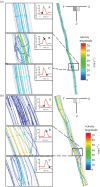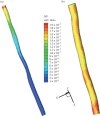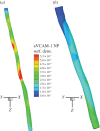Magnetic resonance imaging-based computational modelling of blood flow and nanomedicine deposition in patients with peripheral arterial disease
- PMID: 25878124
- PMCID: PMC4424675
- DOI: 10.1098/rsif.2015.0001
Magnetic resonance imaging-based computational modelling of blood flow and nanomedicine deposition in patients with peripheral arterial disease
Abstract
Peripheral arterial disease (PAD) is generally attributed to the progressive vascular accumulation of lipoproteins and circulating monocytes in the vessel walls leading to the formation of atherosclerotic plaques. This is known to be regulated by the local vascular geometry, haemodynamics and biophysical conditions. Here, an isogeometric analysis framework is proposed to analyse the blood flow and vascular deposition of circulating nanoparticles (NPs) into the superficial femoral artery (SFA) of a PAD patient. The local geometry of the blood vessel and the haemodynamic conditions are derived from magnetic resonance imaging (MRI), performed at baseline and at 24 months post intervention. A dramatic improvement in blood flow dynamics is observed post intervention. A 500% increase in peak flow rate is measured in vivo as a consequence of luminal enlargement. Furthermore, blood flow simulations reveal a 32% drop in the mean oscillatory shear index, indicating reduced disturbed flow post intervention. The same patient information (vascular geometry and blood flow) is used to predict in silico in a simulation of the vascular deposition of systemically injected nanomedicines. NPs, targeted to inflammatory vascular molecules including VCAM-1, E-selectin and ICAM-1, are predicted to preferentially accumulate near the stenosis in the baseline configuration, with VCAM-1 providing the highest accumulation (approx. 1.33 and 1.50 times higher concentration than that of ICAM-1 and E-selectin, respectively). Such selective deposition of NPs within the stenosis could be effectively used for the detection and treatment of plaques forming in the SFA. The presented MRI-based computational protocol can be used to analyse data from clinical trials to explore possible correlations between haemodynamics and disease progression in PAD patients, and potentially predict disease occurrence as well as the outcome of an intervention.
Keywords: atherosclerosis; finite-element modelling; magnetic resonance imaging; nanoparticles; vascular adhesion.
© 2015 The Author(s) Published by the Royal Society. All rights reserved.
Figures











 . Addition of TNF-α under static conditions stimulated upregulation of VCAM-1 by 350%, ICAM-1 by 150% and E-selectin by 250% [44]. (Online version in colour.)
. Addition of TNF-α under static conditions stimulated upregulation of VCAM-1 by 350%, ICAM-1 by 150% and E-selectin by 250% [44]. (Online version in colour.)Similar articles
-
Quantification of blood flow velocity in stenosed arteries by the use of finite elements: an observer-independent noninvasive method.Magn Reson Imaging. 2008 Oct;26(8):1152-9. doi: 10.1016/j.mri.2008.01.013. Epub 2008 Aug 6. Magn Reson Imaging. 2008. PMID: 18687550
-
Reconstruction of blood flow patterns in human arteries.Proc Inst Mech Eng H. 1999;213(5):411-21. doi: 10.1243/0954411991535022. Proc Inst Mech Eng H. 1999. PMID: 10581968
-
A simulation environment for validating ultrasonic blood flow and vessel wall imaging based on fluid-structure interaction simulations: ultrasonic assessment of arterial distension and wall shear rate.Med Phys. 2010 Aug;37(8):4318-30. doi: 10.1118/1.3462592. Med Phys. 2010. PMID: 20879592
-
Emerging vascular applications of magnetic resonance imaging: a picture is worth more than a thousand words.Vascular. 2006 Nov-Dec;14(6):366-71. doi: 10.2310/6670.2006.00062. Vascular. 2006. PMID: 17150158 Review.
-
Computational fluid dynamics in coronary artery disease.Comput Med Imaging Graph. 2014 Dec;38(8):651-63. doi: 10.1016/j.compmedimag.2014.09.002. Epub 2014 Sep 16. Comput Med Imaging Graph. 2014. PMID: 25262321 Review.
Cited by
-
LIFU-responsive nanomedicine enables acoustic droplet vaporization-induced apoptosis of macrophages for stabilizing vulnerable atherosclerotic plaques.Bioact Mater. 2022 Mar 3;16:120-133. doi: 10.1016/j.bioactmat.2022.02.022. eCollection 2022 Oct. Bioact Mater. 2022. PMID: 35386311 Free PMC article.
-
Image-based patient-specific flow simulations are consistent with stroke in pediatric cerebrovascular disease.Biomech Model Mechanobiol. 2021 Dec;20(6):2071-2084. doi: 10.1007/s10237-021-01495-9. Epub 2021 Jul 20. Biomech Model Mechanobiol. 2021. PMID: 34283347 Free PMC article.
-
Magnetic resonance imaging based modeling of microvascular perfusion in patients with peripheral artery disease.J Biomech. 2019 Aug 27;93:147-158. doi: 10.1016/j.jbiomech.2019.06.025. Epub 2019 Jul 8. J Biomech. 2019. PMID: 31331663 Free PMC article.
-
Patient-Specific Flow Descriptors and Normalized wall index in Peripheral Artery Disease: a Preliminary Study.Comput Methods Biomech Biomed Eng Imaging Vis. 2018;6(2):119-127. doi: 10.1080/21681163.2016.1184589. Epub 2016 Oct 12. Comput Methods Biomech Biomed Eng Imaging Vis. 2018. PMID: 29503774 Free PMC article.
-
The Multifaceted Uses and Therapeutic Advantages of Nanoparticles for Atherosclerosis Research.Materials (Basel). 2018 May 8;11(5):754. doi: 10.3390/ma11050754. Materials (Basel). 2018. PMID: 29738480 Free PMC article. Review.
References
-
- Regensteiner JG, Hiatt WR, Coll JR, Criqui MH, Treat-Jacobson D, McDermott MM, Hirsch AT. 2008. The impact of peripheral arterial disease on health-related quality of life in the peripheral arterial disease awareness, risk, and treatment: new resources for survival (PARTNERS) program. Vasc. Med. 13, 15–24. (10.1177/1358863X07084911) - DOI - PubMed
Publication types
MeSH terms
Grants and funding
LinkOut - more resources
Full Text Sources
Other Literature Sources
Medical
Miscellaneous

